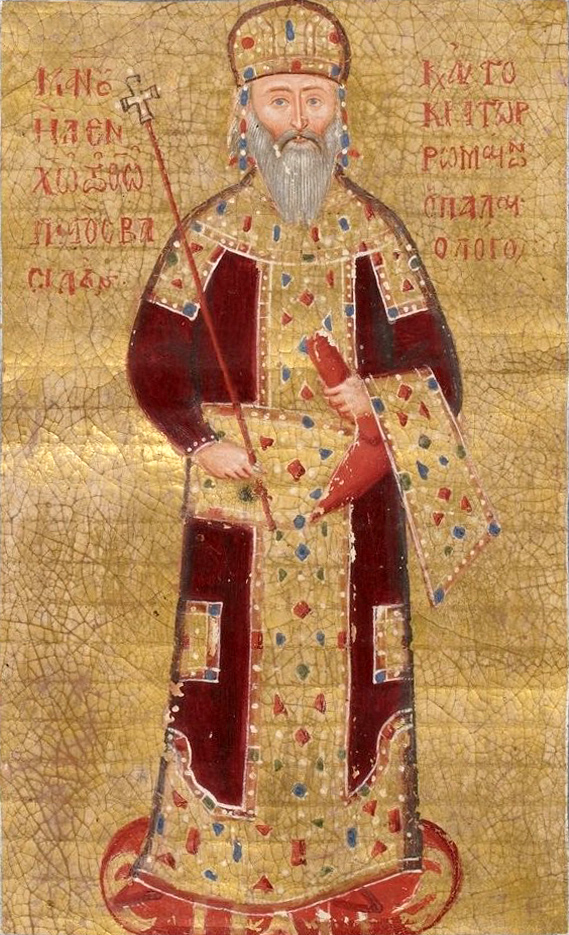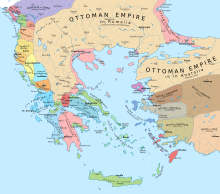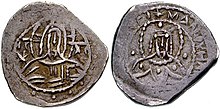Manuel II Palaiologos
| Manuel II Palaiologos | |||||
|---|---|---|---|---|---|
| Emperor and Autocrat of the Romans | |||||
 | |||||
Emperor of the Byzantine Empire | |||||
| Reign | 16 February 1391 – 21 July 1425 | ||||
| Predecessor | John V Palaiologos | ||||
| Successor | John VIII Palaiologos | ||||
| Born | 27 June 1350 Constantinople, Byzantine Empire | ||||
| Died | 21 July 1425(1425-07-21) (aged 75) Constantinople, Byzantine Empire | ||||
| Spouse | Helena Dragaš | ||||
| Issue | Daughter Constantine Palaiologos John VIII Palaiologos Theodore II Palaiologos, Lord of Morea Andronikos Palaiologos, Lord of Thessalonica Daughter Michael Palaiologos Constantine XI Palaiologos Demetrios Palaiologos, Despotēs of the Morea Thomas Palaiologos, Despotēs of the Morea Isabella Palaiologina (illegitimate) | ||||
| |||||
| House | House of Palaiologos | ||||
| Father | John V Palaiologos | ||||
| Mother | Helena Kantakouzene | ||||
Manuel II Palaiologos or Palaeologus (Greek: Μανουήλ Β΄ Παλαιολόγος, Manouēl II Palaiologos; 27 June 1350 – 21 July 1425) was Byzantine Emperor from 1391 to 1425. Shortly before his death he was tonsured a monk and received the name Matthew. His wife Helena Dragaš saw to it that their sons, John VIII Palaiologos and Constantine XI Palaiologos, become emperors. Manuel is commemorated on July 21.[1]
Contents
1 Life
2 Family
3 Ancestry
4 Pope Benedict XVI controversy
5 See also
6 References
7 Further reading
8 External links
Life
Manuel II Palaiologos was the second son of Emperor John V Palaiologos and his wife Helena Kantakouzene.
Granted the title of despotēs by his father, the future Manuel II traveled west to seek support for the Byzantine Empire in 1365 and in 1370, serving as governor in Thessalonica from 1369. The failed attempt at usurpation by his older brother Andronikos IV Palaiologos in 1373 led to Manuel's being proclaimed heir and co-emperor of his father. In 1376–1379 and again in 1390 they were supplanted by Andronikos IV and then his son John VII, but Manuel personally defeated his nephew with help from the Republic of Venice in 1390. Although John V had been restored, Manuel was forced to go as an honorary hostage to the court of the Ottoman Sultan Bayezid I at Prousa (Bursa). During his stay, Manuel was forced to participate in the Ottoman campaign that reduced Philadelpheia, the last Byzantine enclave in Anatolia.

Byzantine double-headed eagle with the Palaiologos family cypher.
Hearing of his father's death in February 1391, Manuel II Palaiologos fled the Ottoman court and secured the capital against any potential claim by his nephew John VII. Although relations with John VII improved, Sultan Bayezid I besieged Constantinople from 1394 to 1402. After some five years of siege, Manuel II entrusted the city to his nephew and embarked (along with a suite of 40 people) on a long trip abroad to seek assistance against the Ottoman Empire from the courts of western Europe, including those of Henry IV of England (making him the only Byzantine emperor ever to visit England – he was welcomed from December 1400 to January 1401 at Eltham Palace, and a joust took place in his honour[2]), Charles VI of France, Sigismund the Holy Roman Emperor, Queen Margaret I of Denmark and king Martin of Aragon. In 1399, the French King Charles VI sent Marshal Jean Le Maingre with six ships carrying 1,200 men from Aigues-Mortes to Constantinople; later 300 men under Seigneur Jean de Chateaumorand remained to defend the city against Bayezid.
Meanwhile, an anti-Ottoman crusade led by the Hungarian King Sigismund of Luxemburg failed at the Battle of Nicopolis on 25 September 1396, but the Ottomans were themselves crushingly defeated by Timur at the Battle of Ankara in 1402. Manuel II had sent 10 ships to help in the Crusade of Nicopolis. As the sons of Bayezid I struggled with each other over the succession in the Ottoman Interregnum, John VII was able to secure the return of the European coast of the Sea of Marmara and of Thessalonica to the Byzantine Empire in the Treaty of Gallipoli. When Manuel II returned home in 1403, his nephew duly surrendered control of Constantinople and received as a reward the governorship of newly recovered Thessalonica. The treaty also regained from the Ottomans Nesebar (1403–1453), Varna (1403–1415), and the Marmara coast from Scutari to Nicomedia (between 1403–1421).

Map of the southern Balkans and western Anatolia in 1410, following the Treaty of Gallipoli

Half stavraton coin by Manuel. On the reverse, Manuel's bust.
On 25 July 1414, with a fleet consisting of four galleys and two other vessels carrying contingents of infantry and cavalry, departed Constantinople for Thessalonica. The purpose of this force soon became clear when he made an unannounced stop at Thasos, a normally unimportant island which was then under threat from a son of the lord of Lesbos, Francesco Gattilusio. It took Manuel three months to reassert imperial authority on the island. Only then did he continue on to Thessalonica, where he was warmly met by his son Andronicus, who then governed the city.
In the spring of 1415, he and his soldiers left for the Peloponnese, arriving at the little port of Kenchreai on Good Friday, 29 March. Manuel II Palaiologos used his time there to bolster the defences of the Despotate of Morea, where the Byzantine Empire was actually expanding at the expense of the remnants of the Latin Empire. Here Manuel supervised the building of the Hexamilion (six-mile wall) across the Isthmus of Corinth, intended to defend the Peloponnese from the Ottomans.
Manuel II stood on friendly terms with the victor in the Ottoman civil war, Mehmed I (1402–1421), but his attempts to meddle in the next contested succession led to a new assault on Constantinople by Murad II (1421–1451) in 1422. During the last years of his life, Manuel II relinquished most official duties to his son and heir John VIII Palaiologos, and went back to Europe searching for assistance against the Ottomans, this time to the King Sigismund of Hungary, staying for two months in his court of Buda. Sigismund (after suffering a defeat against the Turks in the Battle of Nicopolis in 1396) never rejected the possibility of fighting against the Ottoman Empire. However, with the Hussite wars in Bohemia, it was impossible to count on the Czech or German armies, and the Hungarian ones were needed to protect the Kingdom and control the religious conflicts.[3] Unhappily Manuel returned home with empty hands from the Hungarian Kingdom, and in 1424 he and his son were forced to sign an unfavourable peace treaty with the Ottoman Turks, whereby the Byzantine Empire had to pay tribute to the sultan. Manuel II died on 21 July 1425.
Manuel II was the author of numerous works of varied character, including letters, poems, a Saint's Life, treatises on theology and rhetoric, and an epitaph for his brother Theodore I Palaiologos and a mirror of prince for his son and heir Ioannes. This mirror of prince has special value, because it is the last sample of this literary genre bequeathed to us by Byzantines.
Family

A miniature from the Louvre MS. Ivoires 100 manuscript, depicting Manuel II, Helena and three of their sons - the co-emperor John VIII and the Despots Theodore and Andronikos.
By his wife Helena Dragas, the daughter of the Serbian prince Constantine Dragas, Manuel II Palaiologos had several children, including:
- A daughter. Mentioned as the eldest daughter but not named. Possibly confused with Isabella Palaiologina, an illegitimate daughter of Manuel II known to have married Ilario Doria.
- Constantine Palaiologos. Born ca. 1393/8, died before 1405 in Monemvasia.[4]
John VIII Palaiologos (18 December 1392 – 31 October 1448). Byzantine emperor, 1425–1448.
Andronikos Palaiologos, Lord of Thessalonica (d. 1429).- A second daughter. Also not named in the text.
Theodore II Palaiologos, Lord of Morea (d. 1448).- Michael Palaiologos. Born 1406/7, died 1409/10 of the plague.[5]
Constantine XI Dragases Palaiologos (8 February 1405 – 29 May 1453). Despotēs in the Morea and subsequently the last Byzantine emperor, 1448–1453.
Demetrios Palaiologos (c. 1407–1470). Despotēs in the Morea.
Thomas Palaiologos (c. 1409 – 12 May 1465). Despotēs in the Morea.
Ancestry
.mw-parser-output table.ahnentafel{border-collapse:separate;border-spacing:0;line-height:130%}.mw-parser-output .ahnentafel tr{text-align:center}.mw-parser-output .ahnentafel-t{border-top:#000 solid 1px;border-left:#000 solid 1px}.mw-parser-output .ahnentafel-b{border-bottom:#000 solid 1px;border-left:#000 solid 1px}
| Ancestors of Manuel II Palaiologos | |||||||||||||||||||||||||||||||||||||||||||||||||||||||||||||||||||||||||||||||||||||||||||||||||||||||||||||||||||||||||||||||||||||||||||||||||||||||||||||||||||||||||||||||||||||||||||||||||||||||||||||||||||||||||||||||||||||||||||||||||||||||||||||||||||||||||||||||||||||||||||||||||||||||||||||||||||||||||||||||||||||||||||||||||||||||||||||||||||||||||||||||||||||||||||||||||||||||||||||||||||||||||||||||||||||||||||||||||||||||||||||||||||||||||||||||||||||||||||||||||||||||||||||||||||||||||||||||||||||||||||||||||||||||||||||
|---|---|---|---|---|---|---|---|---|---|---|---|---|---|---|---|---|---|---|---|---|---|---|---|---|---|---|---|---|---|---|---|---|---|---|---|---|---|---|---|---|---|---|---|---|---|---|---|---|---|---|---|---|---|---|---|---|---|---|---|---|---|---|---|---|---|---|---|---|---|---|---|---|---|---|---|---|---|---|---|---|---|---|---|---|---|---|---|---|---|---|---|---|---|---|---|---|---|---|---|---|---|---|---|---|---|---|---|---|---|---|---|---|---|---|---|---|---|---|---|---|---|---|---|---|---|---|---|---|---|---|---|---|---|---|---|---|---|---|---|---|---|---|---|---|---|---|---|---|---|---|---|---|---|---|---|---|---|---|---|---|---|---|---|---|---|---|---|---|---|---|---|---|---|---|---|---|---|---|---|---|---|---|---|---|---|---|---|---|---|---|---|---|---|---|---|---|---|---|---|---|---|---|---|---|---|---|---|---|---|---|---|---|---|---|---|---|---|---|---|---|---|---|---|---|---|---|---|---|---|---|---|---|---|---|---|---|---|---|---|---|---|---|---|---|---|---|---|---|---|---|---|---|---|---|---|---|---|---|---|---|---|---|---|---|---|---|---|---|---|---|---|---|---|---|---|---|---|---|---|---|---|---|---|---|---|---|---|---|---|---|---|---|---|---|---|---|---|---|---|---|---|---|---|---|---|---|---|---|---|---|---|---|---|---|---|---|---|---|---|---|---|---|---|---|---|---|---|---|---|---|---|---|---|---|---|---|---|---|---|---|---|---|---|---|---|---|---|---|---|---|---|---|---|---|---|---|---|---|---|---|---|---|---|---|---|---|---|---|---|---|---|---|---|---|---|---|---|---|---|---|---|---|---|---|---|---|---|---|---|---|---|---|---|---|---|---|---|---|---|---|---|---|---|---|---|---|---|---|---|---|---|---|---|---|---|---|---|---|---|---|---|---|---|---|---|---|---|---|---|---|---|---|---|---|---|---|---|---|---|---|---|---|---|---|---|---|---|---|---|---|---|---|---|---|---|---|---|---|---|---|---|---|---|---|---|---|---|---|---|---|---|---|---|---|---|---|---|---|---|---|---|---|---|---|---|---|---|---|---|---|---|---|---|---|---|---|---|---|---|---|---|---|---|---|---|---|---|---|---|---|---|---|---|---|---|---|---|---|---|---|---|---|---|---|---|---|---|---|---|---|---|---|---|---|---|---|---|---|---|---|---|
| |||||||||||||||||||||||||||||||||||||||||||||||||||||||||||||||||||||||||||||||||||||||||||||||||||||||||||||||||||||||||||||||||||||||||||||||||||||||||||||||||||||||||||||||||||||||||||||||||||||||||||||||||||||||||||||||||||||||||||||||||||||||||||||||||||||||||||||||||||||||||||||||||||||||||||||||||||||||||||||||||||||||||||||||||||||||||||||||||||||||||||||||||||||||||||||||||||||||||||||||||||||||||||||||||||||||||||||||||||||||||||||||||||||||||||||||||||||||||||||||||||||||||||||||||||||||||||||||||||||||||||||||||||||||||||||
Pope Benedict XVI controversy
In a lecture delivered on 12 September 2006, Pope Benedict XVI quoted from a dialogue believed to have occurred in 1391 between Manuel II and a Persian scholar and recorded in a book by Manuel II (Dialogue 7 of Twenty-six Dialogues with a Persian) in which the Emperor stated: "Show me just what Muhammad brought that was new and there you will find things only evil and inhuman, such as his command to spread by the sword the faith he preached."
See also
- List of Byzantine emperors
References
This article includes a list of references, but its sources remain unclear because it has insufficient inline citations. (November 2008) (Learn how and when to remove this template message) |
Oxford Dictionary of Byzantium, Oxford University Press, 1991.
^ Great Synaxaristes: (in Greek) Ὁ Ὅσιος Μανουὴλ αὐτοκράτωρ Κωνσταντινουπόλεως. 21 Ιουλίου. ΜΕΓΑΣ ΣΥΝΑΞΑΡΙΣΤΗΣ.
^ Brian Cathcart An emperor in Eltham New Statesman 25 September 2006. It is to be noted however that the Latin Emperor of Constantinople, Baldwin II, visited the court of Henry III on two occasions, in 1238 and 1247, in search of assistance against the Byzantine successor state of Nicaea. Cf. Matthew Paris, Chronica Majora, ed. H.R. Luard, London: 1872–1883, 7 vols. (Rolls series, 57): vol. 3, 480–481; vol. 4, 625–626.
^ Szalay, J. y Baróti, L. (1896). A Magyar Nemzet Története. Budapest, Hungría: Udvari Könyvkereskedés Kiadó.
^ Trapp, Erich; Beyer, Hans-Veit; Kaplaneres, Sokrates; Leontiadis, Ioannis (1989). "21490. Παλαιολόγος Κωνσταντῖνος". Prosopographisches Lexikon der Palaiologenzeit (in German). 9. Vienna: Verlag der Österreichischen Akademie der Wissenschaften. ISBN 3-7001-3003-1..mw-parser-output cite.citation{font-style:inherit}.mw-parser-output .citation q{quotes:"""""""'""'"}.mw-parser-output .citation .cs1-lock-free a{background:url("//upload.wikimedia.org/wikipedia/commons/thumb/6/65/Lock-green.svg/9px-Lock-green.svg.png")no-repeat;background-position:right .1em center}.mw-parser-output .citation .cs1-lock-limited a,.mw-parser-output .citation .cs1-lock-registration a{background:url("//upload.wikimedia.org/wikipedia/commons/thumb/d/d6/Lock-gray-alt-2.svg/9px-Lock-gray-alt-2.svg.png")no-repeat;background-position:right .1em center}.mw-parser-output .citation .cs1-lock-subscription a{background:url("//upload.wikimedia.org/wikipedia/commons/thumb/a/aa/Lock-red-alt-2.svg/9px-Lock-red-alt-2.svg.png")no-repeat;background-position:right .1em center}.mw-parser-output .cs1-subscription,.mw-parser-output .cs1-registration{color:#555}.mw-parser-output .cs1-subscription span,.mw-parser-output .cs1-registration span{border-bottom:1px dotted;cursor:help}.mw-parser-output .cs1-ws-icon a{background:url("//upload.wikimedia.org/wikipedia/commons/thumb/4/4c/Wikisource-logo.svg/12px-Wikisource-logo.svg.png")no-repeat;background-position:right .1em center}.mw-parser-output code.cs1-code{color:inherit;background:inherit;border:inherit;padding:inherit}.mw-parser-output .cs1-hidden-error{display:none;font-size:100%}.mw-parser-output .cs1-visible-error{font-size:100%}.mw-parser-output .cs1-maint{display:none;color:#33aa33;margin-left:0.3em}.mw-parser-output .cs1-subscription,.mw-parser-output .cs1-registration,.mw-parser-output .cs1-format{font-size:95%}.mw-parser-output .cs1-kern-left,.mw-parser-output .cs1-kern-wl-left{padding-left:0.2em}.mw-parser-output .cs1-kern-right,.mw-parser-output .cs1-kern-wl-right{padding-right:0.2em}
^ Trapp, Erich; Beyer, Hans-Veit; Kaplaneres, Sokrates; Leontiadis, Ioannis (1989). "21520. <Παλαιολόγος> Μιχαήλ". Prosopographisches Lexikon der Palaiologenzeit (in German). 9. Vienna: Verlag der Österreichischen Akademie der Wissenschaften. ISBN 3-7001-3003-1.
cf. James V. Schall S.J., The Regensburg Lecture, South Bend IN: St. Augustine's Press, 2007.
Further reading
Manuel II Palaeologus Funeral Oration on His Brother Theodore. J. Chrysostomides (editor & translator). Association for Byzantine Research: Thessalonike, 1985.- Manuel II Palaeologus, The Letters of Manuel II Palaeologus George T. Dennis (translator), Dumbarton Oaks, 1977.
ISBN 0-88402-068-1.
Barker, John (1969). Manuel II Paleologus (1391–1425): A Study in Late Byzantine Statesmanship. Rutgers University Press. ISBN 0-8135-0582-8.
- Karl Förstel (ed.): Manuel II. Palaiologos: Dialoge mit einem Muslim (Corpus Islamo-Christianum. Series Graeca 4). 3 vol. Echter Verlag, Würzburg 1995;
ISBN 3-89375-078-9,
ISBN 3-89375-104-1,
ISBN 3-89375-133-5 (Greek Text with German translation and commentary). - Jonathan Harris, The End of Byzantium. Yale University Press, 2010.
ISBN 978-0-300-11786-8
- Florin Leonte, Rhetoric in Purple: The Renewal of Imperial Ideology in the Texts of Manuel II Palaiologos. PhD dissertation, Central European University, Budapest, 2012
Leonte, Florin (2012), Rhetoric in purple : the renewal of imperial ideology in the texts of emperor Manuel II Palaiologos, CEU ETD collection
Mureşan, Dan Ioan (2010). "Une histoire de trois empereurs. Aspects des relations de Sigismond de Luxembourg avec Manuel II et Jean VIII Paléologue". In Ekaterini Mitsiou et alii. Sigismund of Luxemburg and the Orthodox World (Veröffentlichungen zur Byzanzforschung, 24). Wien: Verlag der Österreichischen Akademie der Wissenschaften. pp. 41–101.
ISBN 978-3-7001-6685-6
Necipoglu, Nevra (2009). Byzantium between the Ottomans and the Latins: Politics and Society in the Late Empire. Cambridge University Press. ISBN 978-0-511-51807-2.
Nicol, Donald M. (1993) [1972]. The Last Centuries of Byzantium, 1261-1453. Cambridge: Cambridge University Press.
Nicol, Donald M. (1996). The Reluctant Emperor: A Biography of John Cantacuzene, Byzantine Emperor and Monk, c. 1295-1383. Cambridge: Cambridge University Press.
- George Sphrantzes. The Fall of the Byzantine Empire: A Chronicle by George Sphrantzes, 1401–1477. Marios Philippides (editor & translator). University of Massachusetts Press, 1980.
ISBN 0-87023-290-8. - Erich Trapp: Manuel II. Palaiologos: Dialoge mit einem „Perser“. Verlag Böhlau, Wien 1966,
ISBN 3-7001-0965-2. (German) - Athanasios D. Angelou, Manuel Palaiologos, Dialogue with the Empress - Mother on Marriage. Introduction, Text and Translation, Vienna, Academie der Wissenschaft, Vienna 1991.
Shukurov, Rustam. The Byzantine Turks (1204-1461). Leiden: Brill.
External links
| Wikimedia Commons has media related to Manuel II Palaiologos. |
- Encyclopedia of Roman Emperors entry
- Manuel Palaeologos Resources, including excerpts from his writings to his son John, on "the virtue of a king"
Historical contemporary references to Manuel II (in Greek) by the Byzantine Greek historian George Sphrantzes
- Portraits of Manuel II
Dialogue 7 with a learned Persian – chapters 1–18 only.
Manuel II Palaiologos Palaiologos dynasty Born: 27 July 1350 Died: 21 July 1425 | ||
| Regnal titles | ||
|---|---|---|
| Preceded by John V Palaiologos | Byzantine Emperor 1391–1425 | Succeeded by John VIII Palaiologos |